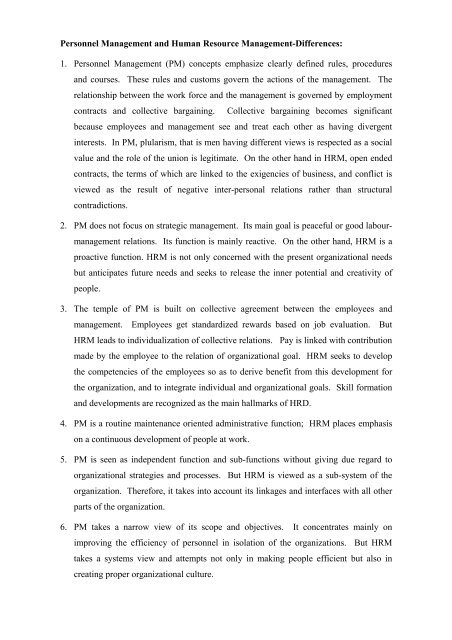UNIT – I Lesson 1 HRM – AN OVERVIEW Lesson Outline Nature of ...
UNIT – I Lesson 1 HRM – AN OVERVIEW Lesson Outline Nature of ...
UNIT – I Lesson 1 HRM – AN OVERVIEW Lesson Outline Nature of ...
Create successful ePaper yourself
Turn your PDF publications into a flip-book with our unique Google optimized e-Paper software.
Personnel Management and Human Resource Management-Differences:<br />
1. Personnel Management (PM) concepts emphasize clearly defined rules, procedures<br />
and courses. These rules and customs govern the actions <strong>of</strong> the management. The<br />
relationship between the work force and the management is governed by employment<br />
contracts and collective bargaining. Collective bargaining becomes significant<br />
because employees and management see and treat each other as having divergent<br />
interests. In PM, plularism, that is men having different views is respected as a social<br />
value and the role <strong>of</strong> the union is legitimate. On the other hand in <strong>HRM</strong>, open ended<br />
contracts, the terms <strong>of</strong> which are linked to the exigencies <strong>of</strong> business, and conflict is<br />
viewed as the result <strong>of</strong> negative inter-personal relations rather than structural<br />
contradictions.<br />
2. PM does not focus on strategic management. Its main goal is peaceful or good labourmanagement<br />
relations. Its function is mainly reactive. On the other hand, <strong>HRM</strong> is a<br />
proactive function. <strong>HRM</strong> is not only concerned with the present organizational needs<br />
but anticipates future needs and seeks to release the inner potential and creativity <strong>of</strong><br />
people.<br />
3. The temple <strong>of</strong> PM is built on collective agreement between the employees and<br />
management. Employees get standardized rewards based on job evaluation. But<br />
<strong>HRM</strong> leads to individualization <strong>of</strong> collective relations. Pay is linked with contribution<br />
made by the employee to the relation <strong>of</strong> organizational goal. <strong>HRM</strong> seeks to develop<br />
the competencies <strong>of</strong> the employees so as to derive benefit from this development for<br />
the organization, and to integrate individual and organizational goals. Skill formation<br />
and developments are recognized as the main hallmarks <strong>of</strong> HRD.<br />
4. PM is a routine maintenance oriented administrative function; <strong>HRM</strong> places emphasis<br />
on a continuous development <strong>of</strong> people at work.<br />
5. PM is seen as independent function and sub-functions without giving due regard to<br />
organizational strategies and processes. But <strong>HRM</strong> is viewed as a sub-system <strong>of</strong> the<br />
organization. Therefore, it takes into account its linkages and interfaces with all other<br />
parts <strong>of</strong> the organization.<br />
6. PM takes a narrow view <strong>of</strong> its scope and objectives. It concentrates mainly on<br />
improving the efficiency <strong>of</strong> personnel in isolation <strong>of</strong> the organizations. But <strong>HRM</strong><br />
takes a systems view and attempts not only in making people efficient but also in<br />
creating proper organizational culture.
















